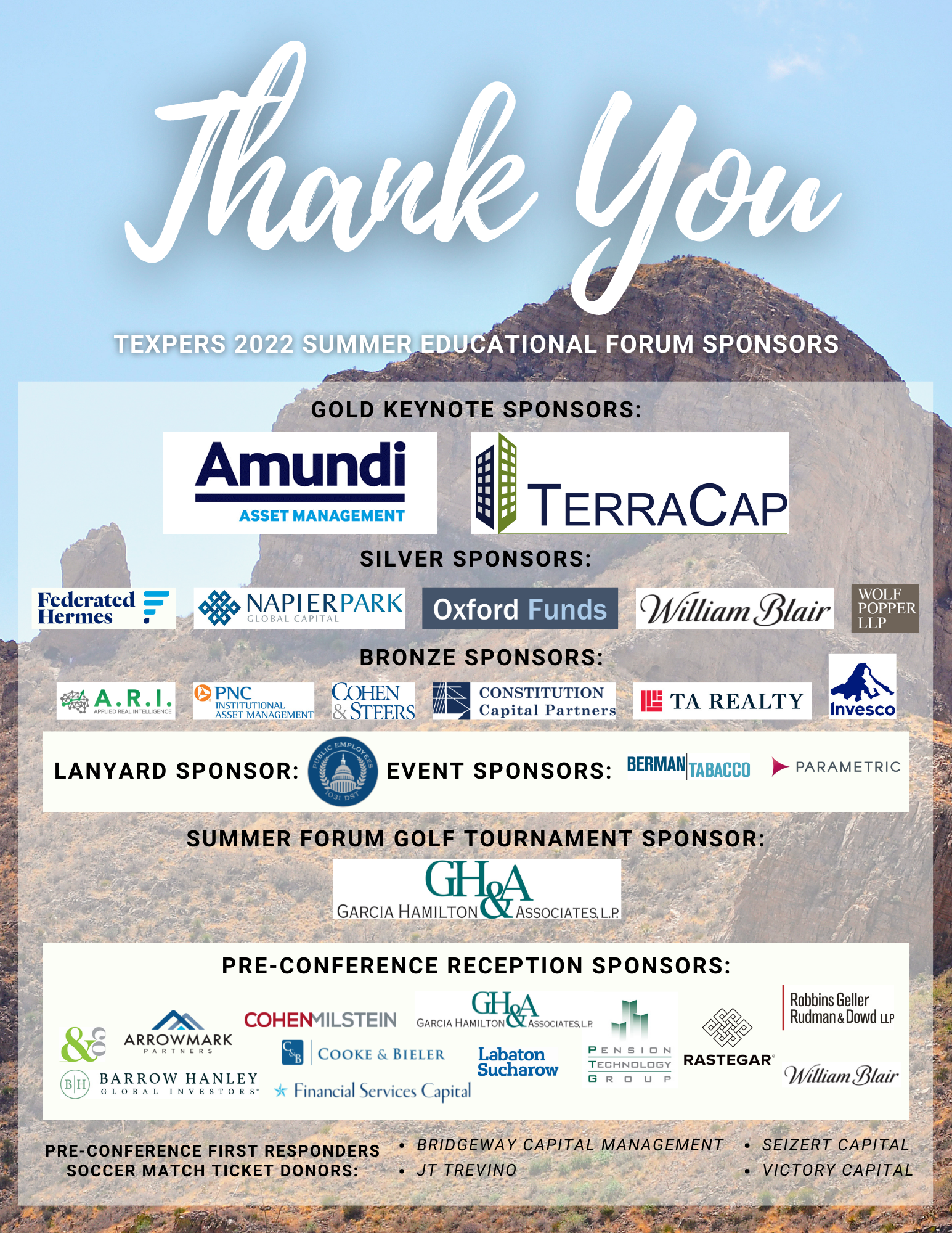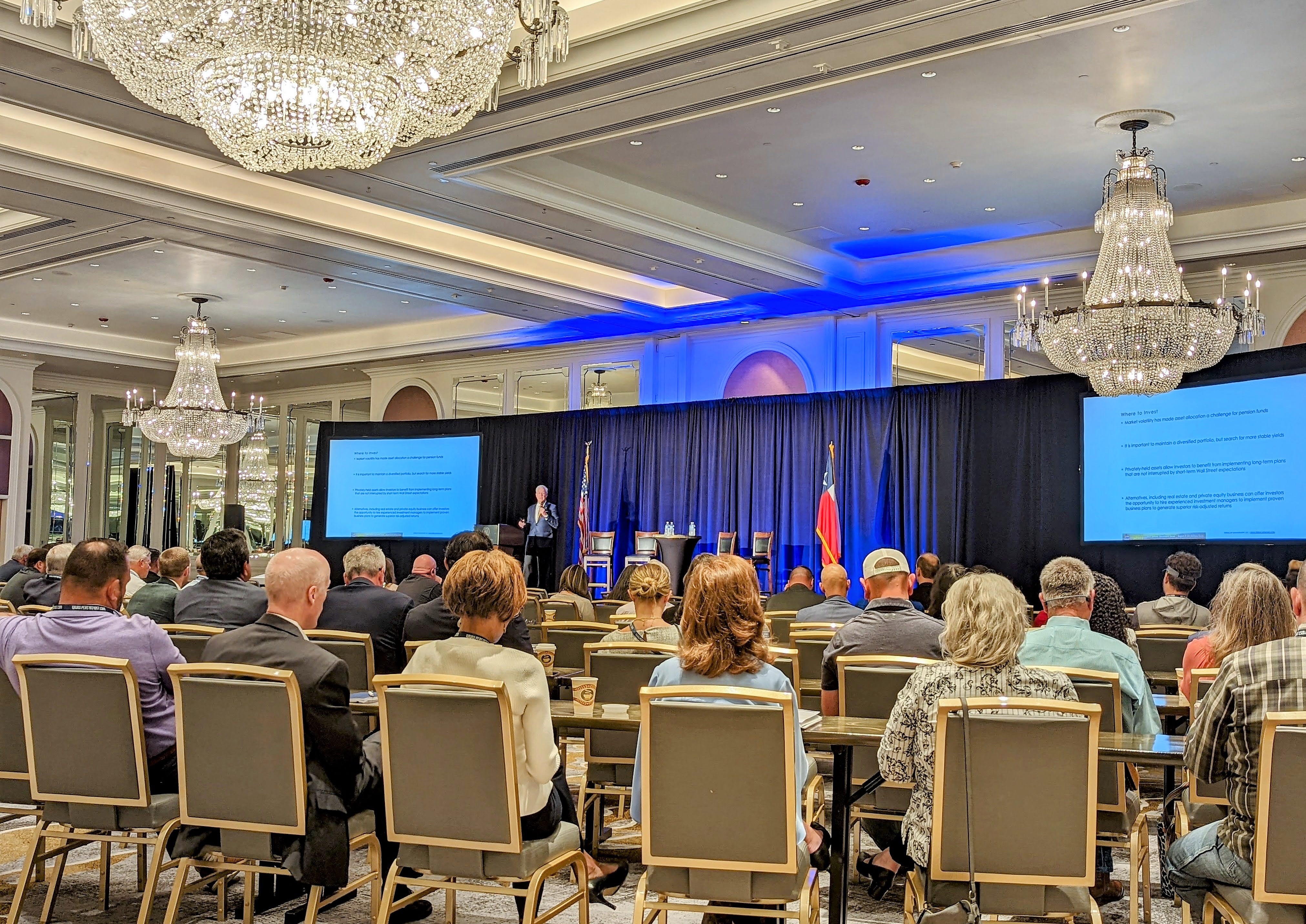Nearly 270 people attended TEXPERS' Summer Educational Forum, Aug. 21-23, 2022, in El Paso, located in the far western corner of the Lone Star State, bordering Mexico.
Our Forum attendees were able to enjoy comfortable temperatures thanks to a bout of rain in El Paso, usually known for its approximately 302 sunny days each year. Combined with a walkable downtown district and the historic Hotel Paso Del Norte Marriott Autograph Collection, the Forum made for successful professional development and networking opportunity.
See TEXPERS' 2022 Summer Educational Forum Photo Album
"The event, hosted by our Association, brought together thought leaders to discuss topics trustees and administrators of public pension systems need to know when managing annuitants' retirement funds," says TEXPERS Executive Director Art Alfaro. "The theme, Sharing Solutions in Sun City, challenged our presenters to develop content that not only provided our attendees with information but that would allow them to return to their funds with actionable ideas. Our Forum also provided ample opportunities for all of our System and Associate members to network."
Each year, the Forum offers plenty of ideas, tips, and insights into the public employee pension and investment industry. The event held in El Paso was no exception.
The following list includes notes we took from our #TEXPERS2022 Summer Educational Forum presentations:

1. "Inflation occurs with a decrease in supply and increase in demand." - From Current Market Environment, an Educational Workshop presented by Sean Windsor, Champion Capital Research
Notes: The term inflation refers to the general increase in prices of goods and services in economics. Inflation reduces the purchasing power of money when the general price level rises, resulting in fewer goods and services being available for sale.
2. "You can see that 13.8% of the total US workforce is part of pension plans or state and local employees." - Historic & Current Market Volatility, What Are Implications to Investors?, Keynote Presentation by Steve Hagenbuckle, TerraCap Management
Notes: Social Security coverage is unavailable to 25% of this workforce. In addition:
- 66% of firefighters and law enforcement do not receive SS benefits
- 50% of teachers do not receive SS benefits
3. "We've done some calculations; for the next 5 to 10 years, emerging market equities will probably be the No. 1 returning asset class, close to 5%, followed by international small caps, then emerging market debt ... and obviously international." - Emerging Markets on the Edge: Opportunity or Dead Money?, Presentation by Martin Schulz, Federated Hermes
Notes: Some of the worse assets will be US bonds, US large caps, and US small caps. The US still represents a quarter of GDP. Emerging Markets = More than a third of GDP, not just China.
4. "It is important to note that there are only five systems that have an L-FSRP [Legacy-Funding Soundness Restoration Plan] and that there will not be any more than that." - Funding Soundness Restoration Plan Overview: Understanding the Rules and Policy, Presented by Ashley Rendon, Texas Pension Review Board
Notes: That's because when any FSRP was submitted before Sept. 1, 2021 deadline, the system was grandfathered, and their 10-year period is able to play out. However, the system is subject to progress updates to the PRB every two years.
5. "What is ESG shareholder litigation? It is securities litigation or a case brought by shareholders relating in some way to an environmental, social or governance issue." - The Case For and Against Shareholders Litigating ESG Issues, Presented by Joshua W. Ruthizer, Esq., Wolf Popper, LLP; James Smith, San Antonio Fire & Police Pension Fund; and Tyler Grossman, El Paso Firemen & Policemen's Pension Fund
Notes: Whatever your funds' views are on ESG investing, trustees should be aware of ESG shareholder litigation options as there have been federal and state cases.
6. "As you know, the fed has been raising rates pretty dramatically, so we think middle market, direct lending, and private credit is a strong strategy." - Diversifying Strategies in an Inflationary Environment, moderated by Kevin Vandolder of AndCo Consulting featuring thought leaders Steve Shekane, Constitution Capital Partners; Daniel Brady, PNC Capital Advisors; and Zack Ellison, Applied Real Intelligence
Notes: Floating interest rates. As rates go up, getting paid more interest on underlying investments. (Middle markest are $100 million and below).
7. "Since the global financial crisis, we've really been in a favorable financial environment for risk assets - not only risk assets - fixed income as well, low to falling rates, stable growth. It has been really 60/40 portfolio going back to 2008-2009. It has been asset allocation that has beat most others but now, as we're changing, the investment landscape is shifting a bit with inflation, growth concerns, and rising rates - that level of diversification probably isn't going to cut it." - Getting Real with Real Assets: Important Implications in a Shifting Economic Landscape, moderated by Scott Whalen, Verus Investments and featuring thought leaders Marcus Berry, TA Realty Michele Butler, Cohen & Steers Brian Watson, Invesco
(Panel did not feature a slide presentation)
Notes: Areas experts represented included real estate, commodities, and midstream energy.
8. "What is a dislocation? This is observed as a precipitous decline in market pricing. This can be caused by one of two things: Either it's because of market-specific stress or because of exogenous shock. - Navigating Market Dislocations presented by Amit Sanghani, Napier Park Global
Notes: Events of the last two years, pandemic, is an example of an exogenous or external factor. A specific market stress example is the late-2015/early-2016 energy oil and gas crisis, which had particular impacts on different markets.
9. "Emerging market debt is fixed income securities issued by governments, state-owned entities, also known as quasi-sovereigns, and corporations." - Emerging Markets Debt, Jared Lou, William Blair & Company
Download PowerPoint Presentation
Notes: Emerging Markets Debt, or EMD, can be issued in hard currencies such as U.S. dollars, Euro, British Pound, Japanese Yen, and other currencies. Issuers can also issue in local currencies such as the Mexican Peso and the Brazilian Real.
10. "The power of a defined benefit plan versus a defined contribution plan is enormous. So the pooling that comes from just simply having the same assets and the same pool, right away, you have scale. So, when you think about a defined contribution plan and each individual is investing on his or her own, the fee scale is tremendously different. So, just the fees alone are a huge saving in a defined benefit plan versus a defined contribution plan." - The Power of Pooling & Challenges for Public Pensions, presented by Charles Millard, Amundi Asset Management
Download PowerPoint Presentation
Notes: Early baby-boomer retirees who have a defined benefit plan and retire at 65 are 11.6% less likely to run out of money for retirement.
11. "What we do for one pension system isn't the same for all. Outsourcing model doesn't have to be the same for your neighbor." - Outsourcing Administrative Services, panel moderated by Paul Brown, Big Spring Firemen's Relief & Retirement Fund featuring thought leaders Stephanie Masson and AJ Weber of Lauterbach & Amen LLP
Download PowerPoint Presentation
Notes: Outsourcing requests can include backup for when administrators leave positions, such as in accounting, meeting coordination, tax reporting, customer service, contribution reports, etc.
12. "CLO equity offers mid-teens returns, and there's just not a lot of things that offers those level of returns today." - The Case for CLO Equity; Why CLO Equity, Why Now?, presented by Chris Mascarinas, Oxford Funds
Download PowerPoint Presentation
Notes: CLOs, or collateralized loan obligations, are primarily broadly syndicated U.S. Corporate Loans. They differ from CDOs, or collateralized debt obligations, which hold toxic stuff such as mortgage-backed and asset-backed securities. Biggest difference is CLOs have few defaults.



